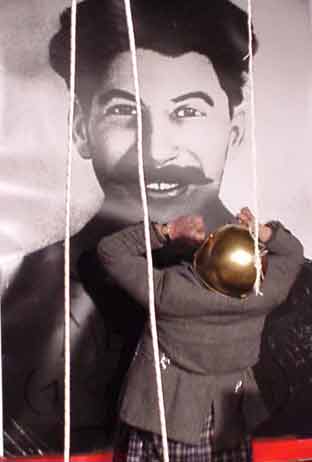Jonathan Meese
dal 15/2/2006 al 25/3/2006
Segnalato da
15/2/2006
Jonathan Meese
Modern Art, London
Constructed environments, installations and paintings provide the stage for Meese’s elaborate investigation into the structure and dissemination of power. Meese’s early ‘pop historical’ installations drew literal references from the popular culture that surrounded him as a teenager.

Thanks, Wally Whyton
Modern Art is pleased to present German artist, Jonathan Meese’s second solo show with
the gallery.
Constructed environments, installations and paintings provide the stage for Meese’s elaborate
investigation into the structure and dissemination of power.
Meese’s early ‘pop historical’ installations drew literal references from the popular culture that
surrounded him as a teenager. Appropriating the visual language used by his heroes, Meese would create
vast and chaotic installations. The films of Iconic directors, such as Stanley Kubrick’s Clockwork
Orange and John Boorman’s commercial failure, Zardoz, (starring Sean Connery), became the inspiration
and spirit behind Meese’s installations. These overtly staged settings would take the form of
intensified compositions where immense landscapes of images, memorabilia and theatrical props would
jostle maniacally beside one another. The heavily etched text that sprawled across the space punctuated
and further personalised what looked to be the fevered collection of an obsessive music and film
fanatic.
Language in its varied forms has a central role within Meese’s work, acting as a narrative device that
allows the artist a platform for self-interrogation and expression. As a child, Meese engaged with the
world in a language made from composite linguistic forms without the burden of learned grammatical
protocol. This would progress and develop to an extreme level that eventually manifested as
communication through a complex lexicon of sounds and gestures. Through the encouragement of his
mother, Meese would learn to move these noises on to the page, developing the distinctive written
language that now forms a central element of the artist’s practice.
Meese’s solo performances are fuelled by the same impassioned and impulsive energies evident in the
creation of his paintings and installations. The sole performer in most of these works, Meese plays
many and varied roles. Characters are displaced from their comfortable homes in Greek mythology and
historical records and are placed alongside creatures from Meese’s own fictitious storytelling. Key
motifs and characters reappear in Meese’s stories in the same way that villains might return to a
narrative, unresolved and undefeated. Crosses, stars and uniforms all play critical roles in Meese’s
performances as symbols of power and manipulation. Meese is fascinated with despotic and philosophical
figures throughout history, all driven and engulfed by their own singular visions and idealistic
systems that would eventually lead to their inevitable downfall, with particular reference to
Nietzsche, the Marquis de Sade, Caligula, Stalin and Hitler. By acting out or making nonsense of their
actions, Meese deconstructs or seeks to make sense of their processes, regularly showing them in their
most extreme or sadistic states. Often aggressive and locked into a trance-like state, Meese takes
centre stage rising and falling in emotional intensity; building, reordering and destroying his stage
set within each movement.
Meese has now gradually returned to painting as a pure surface upon which to investigate and express
the energies that have consumed his performances and installations. Meese’s later work is now
characterised by a progressively more absolute aesthetic, both referential to his earlier chaotic work
alongside an increasingly sophisticated visual repertoire.
Private View 16 February
Modern Art
10 Vyner Street - London



